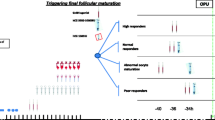Abstract
Purpose
Mild controlled ovarian hyperstimulation (COH), combined with oocyte retrieval (OR) under local anaesthesia (LA), may provide low-impact IVF. Since a single injection of corifollitrophin alfa (CFA) provides 7 days of COH, we hypothesised that clomiphene-citrate (CC) followed by CFA may provide adequate COH response from one single FSH injection. Therefore, the aim was to assess IVF outcomes after a novel clomiphene citrate/CFA (CC/CFA) protocol, compared to women undergoing standard rFSH COH protocols (good prognosis comparative cohort:GPCC) in a 1:2 matched design.
Materials and methods
In this pilot study of 25 patients (ANZCTR id:ACTRN12612000740897, MINIVA:Minimal_Stimulation_in_IVF), we examined the effectiveness of oral clomiphene (100 mg-days 2–6) followed by CFA in a GnRH antagonist protocol producing a single injection COH stimulation regime. All OR were conducted under LA pre-ovarian block. Cycle outcomes were compared to a matched good prognosis comparative cohort (GPCC) undergoing standard rFSH COH.
Results
Mild stimulation was achieved with less oocytes being collected compared to the GPCC (6.4 ± 0.7 vs. 10.7 ± 0.9, p < 0.001), resulting in a reduced number of good quality embryos available for transfer/cryopreservation (3.7 ± 0.6 vs. 5.7 ± 0.5, p = 0.01). While embryo quality was similar between the two groups, endometrial thickness was significantly lower in the group receiving CC/CFA. Pregnancy rates were significantly lower in the CC/CFA cohort compared to GPCC (31.8 vs. 57.1%, p = 0.04) and 44% of CC/CFA participants required supplemental rFSH in order to achieve the hCG trigger criteria.
Conclusion
Sequential clomiphene CFA protocol does not appear to be an optimal regime for low impact IVF treatment as it does not provide adequate COH from a single CFA injection and results in lower fresh embryo transfer pregnancy rates and fewer embryos for cryopreservation.
Similar content being viewed by others
References
Theraputic goods administration product approval for CCF. Available from: https://www.ebs.tga.gov.au/ebs/picmi/picmirepository.nsf/pdf?OpenAgent&id=CP-2010-PI-07204-3.
van den Wijngaard L, Rodijk ICM, van der Veen F, Gooskens-van Erven MHW, Koks CAM, Verhoeve HR, et al. Patient preference for a long-acting recombinant FSH product in ovarian hyperstimulation in IVF: a discrete choice experiment. Hum Reprod. 2015;30(2):331–7.
Devroey P, Boostanfar R, Koper NP, Mannaerts BMJL, IJzerman-Boon PC, Fauser BCJM, et al. A double-blind, non-inferiority RCT comparing corifollitropin alfa and recombinant FSH during the first seven days of ovarian stimulation using a GnRH antagonist protocol. Hum Reprod. 2009;24(12):3063–72.
Group, C.a.E.S. Corifollitropin alfa for ovarian stimulation in IVF: a randomized trial in lower-body-weight women. Reprod BioMed Online. 2010;21(1):66–76.
Fauser BC, et al. Mild ovarian stimulation for IVF: 10 years later. Hum Reprod. 2010;25(11):2678–84.
Steptoe PC, Edwards RG, Walters DE. Observations on 767 clinical pregnancies and 500 births after human in-vitro fertilization. Hum Reprod. 1986;1(2):89–94.
Kato K, Takehara Y, Segawa T, Kawachiya S, Okuno T, Kobayashi T, et al. Minimal ovarian stimulation combined with elective single embryo transfer policy: age-specific results of a large, single-Centre, Japanese cohort. Reprod Biol Endocrinol. 2012;10:35.
Zhang JJ, Merhi Z, Yang M, Bodri D, Chavez-Badiola A, Repping S, et al. Minimal stimulation IVF vs conventional IVF: a randomized controlled trial. Am J Obstet Gynecol. 2016;214(1):96.e1–8.
Sunkara SK, Rittenberg V, Raine-Fenning N, Bhattacharya S, Zamora J, Coomarasamy A. Association between the number of eggs and live birth in IVF treatment: an analysis of 400 135 treatment cycles. Hum Reprod. 2011;26(7):1768–74.
McLernon DJ, Maheshwari A, Lee AJ, Bhattacharya S. Cumulative live birth rates after one or more complete cycles of IVF: a population-based study of linked cycle data from 178,898 women. Hum Reprod. 2016;31(3):572–81.
Nargund G, Datta AK, Fauser BCJM. Mild stimulation for in vitro fertilization. Fertil Steril. 2017;108(4):558–67.
Balen AH, Morley LC, Misso M, Franks S, Legro RS, Wijeyaratne CN, et al. The management of anovulatory infertility in women with polycystic ovary syndrome: an analysis of the evidence to support the development of global WHO guidance. Hum Reprod Update. 2016;22(6):687–708.
Australian Public Assessment Report for Corifollitropin alfa. T.G. In: Administration; 2010.
Cerne A, Bergh C, Borg K, Ek I, Gejervall AL, Hillensjö T, et al. Pre-ovarian block versus paracervical block for oocyte retrieval. Hum Reprod. 2006;21(11):2916–21.
Rawal N, Berggren L. Organization of acute pain services: a low-cost model. Pain. 1994;57(1):117–23.
van der Linden, M., et al., Luteal phase support for assisted reproduction cycles. Cochrane Database Syst Rev, 2015(7): p. CD009154.
Gardner DK, Lane M, Stevens J, Schlenker T, Schoolcraft WB. Blastocyst score affects implantation and pregnancy outcome: towards a single blastocyst transfer. Fertil Steril. 2000;73(6):1155–8.
Feil D, Henshaw RC, Lane M. Day 4 embryo selection is equal to day 5 using a new embryo scoring system validated in single embryo transfers. Hum Reprod. 2008;23(7):1505–10.
Dickey RP, Olar TT, Taylor SN, Curole DN, Matulich EM. Relationship of endometrial thickness and pattern to fecundity in ovulation induction cycles: effect of clomiphene citrate alone and with human menopausal gonadotropin. Fertil Steril. 1993;59(4):756–60.
Bonhoff AJ, Naether OG, Johannisson E. Effects of clomiphene citrate stimulation on endometrial structure in infertile women. Hum Reprod. 1996;11(4):844–9.
AbdelHafez FF, Desai N, Abou-Setta AM, Falcone T, Goldfarb J. Slow freezing, vitrification and ultra-rapid freezing of human embryos: a systematic review and meta-analysis. Reprod BioMed Online. 2010;20(2):209–22.
Iliodromiti S, Blockeel C, Tremellen KP, Fleming R, Tournaye H, Humaidan P, et al. Consistent high clinical pregnancy rates and low ovarian hyperstimulation syndrome rates in high-risk patients after GnRH agonist triggering and modified luteal support: a retrospective multicentre study. Hum Reprod. 2013;28(9):2529–36.
Author information
Authors and Affiliations
Corresponding author
Rights and permissions
About this article
Cite this article
Zander-Fox, D., Lane, M., Hamilton, H. et al. Sequential clomiphene/corifollitrophin alpha as a technique for mild controlled ovarian hyperstimulation in IVF: a proof of concept study. J Assist Reprod Genet 35, 1047–1052 (2018). https://doi.org/10.1007/s10815-018-1172-y
Received:
Accepted:
Published:
Issue Date:
DOI: https://doi.org/10.1007/s10815-018-1172-y




